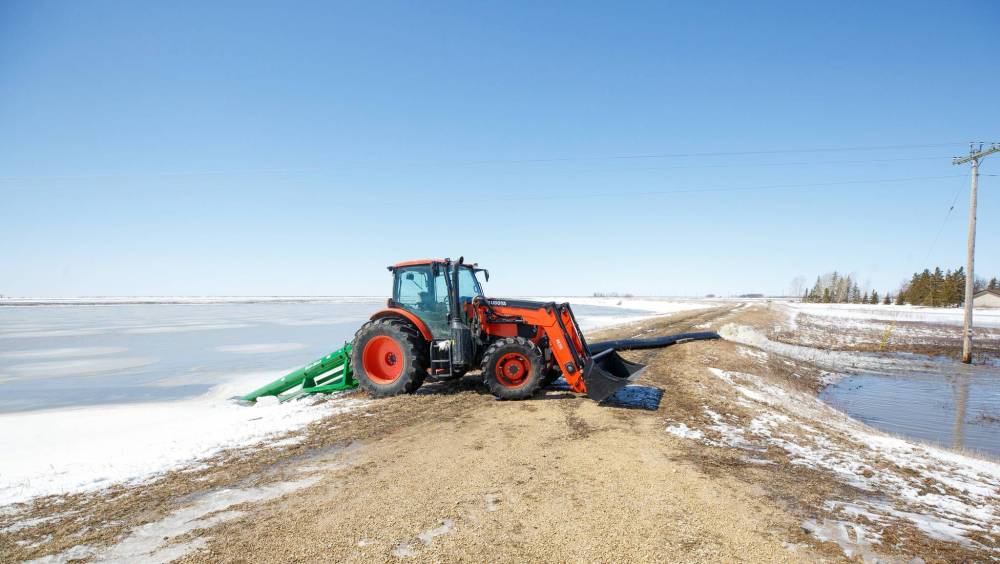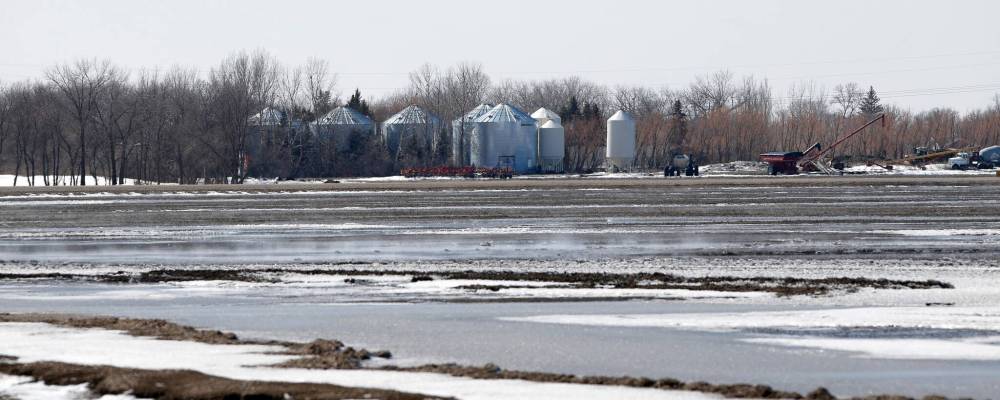Farmers fear serious seeding setback
Producers worry as rain, snow keep fields soaked
Advertisement
Read this article for free:
or
Already have an account? Log in here »
To continue reading, please subscribe:
Monthly Digital Subscription
$0 for the first 4 weeks*
- Enjoy unlimited reading on winnipegfreepress.com
- Read the E-Edition, our digital replica newspaper
- Access News Break, our award-winning app
- Play interactive puzzles
*No charge for 4 weeks then price increases to the regular rate of $19.00 plus GST every four weeks. Offer available to new and qualified returning subscribers only. Cancel any time.
Monthly Digital Subscription
$4.75/week*
- Enjoy unlimited reading on winnipegfreepress.com
- Read the E-Edition, our digital replica newspaper
- Access News Break, our award-winning app
- Play interactive puzzles
*Billed as $19 plus GST every four weeks. Cancel any time.
To continue reading, please subscribe:
Add Free Press access to your Brandon Sun subscription for only an additional
$1 for the first 4 weeks*
*Your next subscription payment will increase by $1.00 and you will be charged $16.99 plus GST for four weeks. After four weeks, your payment will increase to $23.99 plus GST every four weeks.
Read unlimited articles for free today:
or
Already have an account? Log in here »
Hey there, time traveller!
This article was published 27/04/2022 (1325 days ago), so information in it may no longer be current.
Last year, Manitoba’s agriculture community was parched and praying for rain. Now, it’s begging for the storms to stop.
“Any moisture at this point is not helpful at all,” said Jeff Hamblin, a farmer near Morris.
The town is preparing for a flood: weather forecasts predict another Colorado low dumping rain on Manitoba after back-to-back weekends of precipitation and a blizzard-filled winter.

About half of Hamblin’s 6,000 acres will be underwater if projections become reality, he said.
“The way it looks like it’s going to work out, it’ll probably delay seeding for at least a month,” he said. “That’ll end up costing us a lot of money.”
He typically starts planting around April 23. Beginning seeding after this week means a big decrease in cereal yields like oats and barley, Hamblin said.
Crops put in late could be subject to death by fall frost, he added.
“If the taps turned off here for the next month, it’d be perfect,” he said of the weather. “Let us get some temperatures back up, let the soil warm up and dry out, and let us get that crop in the ground.”
He’s been considering changing his crops because of the late start. But, he fertilized for specific plants last fall, he’s already ordered seed and he’s made pre-sales to wheat elevators.
Flooding has already damaged his fields. It’s erased the drainage ditches Hamblin said it takes hundreds of hours to create.
“We’ll pray for no excess moisture during the growing season, and then in the fall, hopefully we can restore some of that drainage,” he said.
Shortages, drought and war have contributed to higher commodity prices, Hamblin noted. He’d hoped a plentiful crop season could be the time to make good money.
“We don’t know what next year might bring,” he said. “If our cost of production goes up and commodities drop off, we could be in the situation where we can’t make any money… I think we were all hoping for the real Hail Mary this year.”
Over in Glenboro, Andrea Hamilton is putting more labour into caring for her 170 cows than usual. It’s calving season.
“We’re not prepared for (the weather),” she said. “That’s why we don’t calve in January and March.”
She said she’s been lucky — her farm is on sand, which can handle moisture better, and she has a calf shelter. Still, she’s been checking on her calves more because of the weather.
Hamilton said she has friends who monitor their calves throughout the cold nights and drive to their herds in vehicles they haven’t used for such purposes before, like tractors. Some have to dig their way to the animals.
“When there’s storm systems that come through, they have to get out there hourly,” said Carson Callum, general manager for the Manitoba Beef Producers.
“They’ve got to make sure (the calves) have access to shelter as best they can, to get out of the wind and the snow and the rain.”
Over 1,000 calves have taken ill — with many dying — due to the weather, Callum said. Farmers have been sheltering the young cows in their trucks and homes to keep them safe, he added.
Roughly 400,000 cows on 6,000 beef farms call Manitoba home, he said.
Another worry is feed: cows are usually grazing grass by this time. Some farmers are running out of stockpiled hay and grain.
“Any feed that’s left out there right now is very high priced, to the point where it’s not really feasible but you have to keep your cattle alive,” said Lawrence Knockaert, chairman of the Manitoba Forage and Grassland Association.
He’s hoping government will extend the Livestock Feed and Transportation Drought Assistance program, which provided reimbursement for winter feed costs up to April 15.

Knockaert, who lives in Bruxelles, said his area is “sitting pretty nice” with the precipitation levels.
“We needed the rain,” he said. “There was cracks in the fall in the pastures that were half (an) inch wide.”
But, it’s been too much for other regions, he noted.
Callum called the latest rain and snow a “double-edged sword”: the added moisture is good long term, but the pooling water and storms have been challenging.
Most of the recent precipitation has become runoff or pooling, according to Mario Tenuta, a senior industrial research chair in the University of Manitoba’s soil science department.
“The water has nowhere to go right now,” he said, adding the soil is still frozen a few inches below the surface.
Rains last fall provided a bit of relief after a summer of drought, Tenuta said. But, the current above ground water is too much, he said.
“If the soil does become saturated, which it likely will, then it’s going to… delay planting because the farmers can’t get onto the soil.”
He predicts the soil will warm this week, allowing more water to enter. So, while producers can’t trek their fields, weeds can flourish, absorb nitrogen and take space. Additionally, a mix of warm and wet soil could reduce already distributed fertilizer, Tenuta said.
“Right now, nitrogen is extremely, extremely expensive,” he said.
Hamblin from Morris said he’d pay $60 to $70 per acre for fertilizer; now, he’s looking at $200 for the same area.
“Ideally, what I’d like to see is the surface water drains sideways, laterally to ditches, drains and leaves,” Tenuta said. “But, if the Red River is very high, that may not happen very well.”
Both Morgan Cott from the Manitoba Crop Alliance and Bill Campbell, president of the Keystone Agricultural Producers, hope the forecast rain passes Manitoba this weekend.
“Like a lot of things in life, timing and balance are very important,” Campbell said. “Too much or too little of any one thing at one time can be detrimental.”
Cott is crossing fingers for regular rains this summer.
“Farming is just a gamble,” the agronomy extension specialist said. “It’s just hoping for the best scenario all the time.”
Environment Canada forecast rain Friday through Sunday as of Tuesday afternoon.
gabrielle.piche@winnipegfreepress.com

Gabby is a big fan of people, writing and learning. She graduated from Red River College’s Creative Communications program in the spring of 2020.
Our newsroom depends on a growing audience of readers to power our journalism. If you are not a paid reader, please consider becoming a subscriber.
Our newsroom depends on its audience of readers to power our journalism. Thank you for your support.



